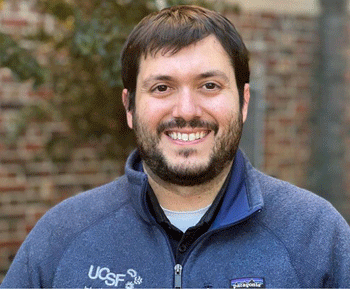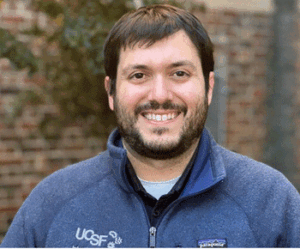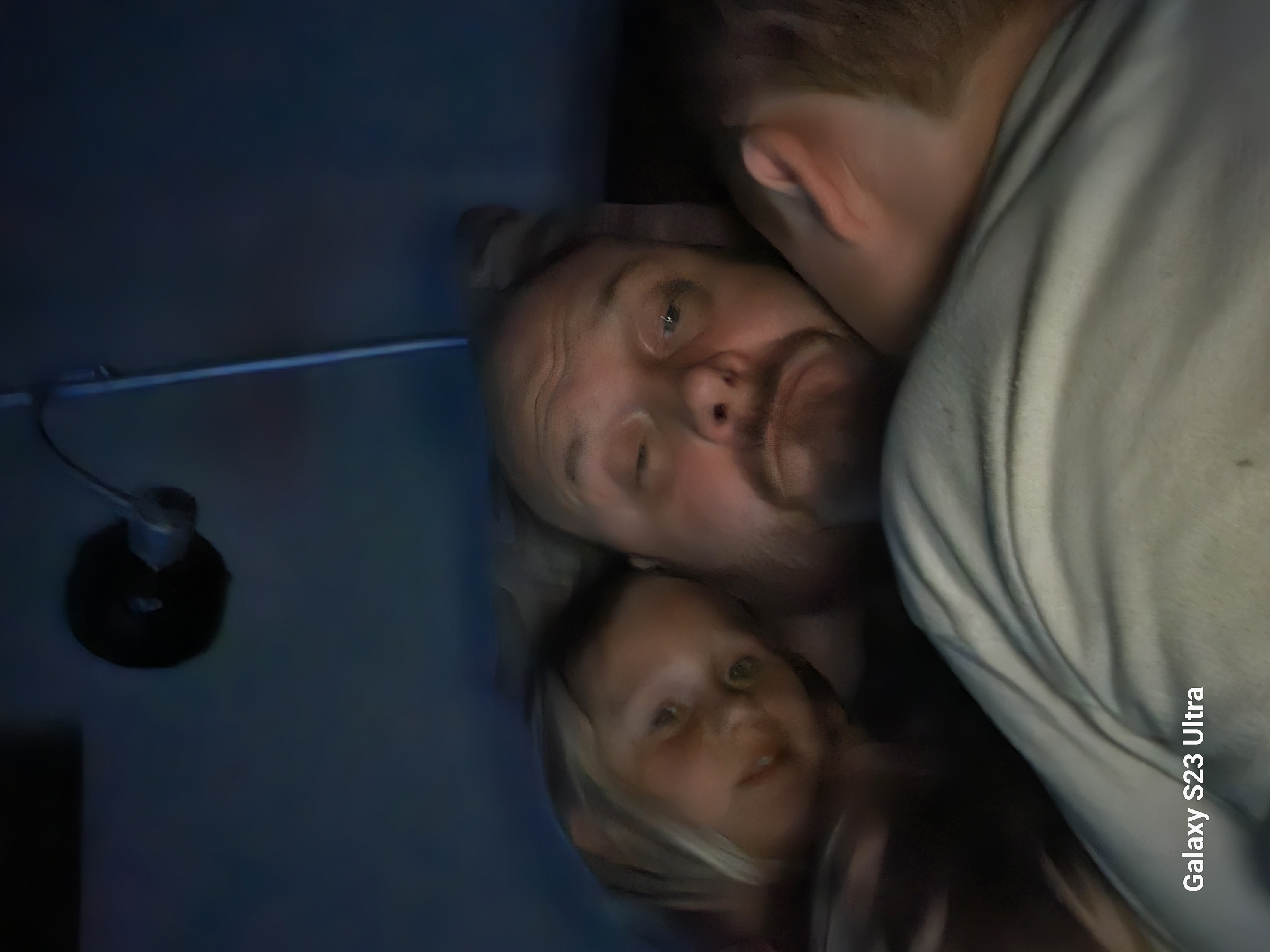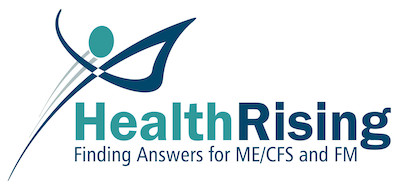

Geoff’s Narrations
The GIST
“Getting to know the people with long COVID and be a part of their journey with this terrible condition is very special to me, and I think that’s true of many people working in this field.” Dr. Peluso

An infectious disease specialist, Michael Peluso MD helped create and run the LIINC long-COVID project at UCSF.
Dr. Michael Peluso, MD, is an infectious disease clinician and researcher, as well as the director and one of the co-creators of the large Long Term Impact of Infection with Novel Coronavirus (LIINC) project at UCSF.
In a recent Zoom interview, I talked with him about his work in long COVID and his thoughts on ME/CFS.
The Mighty LIINC Project
Health Rising has hailed UCSF’s LIINC project many times. With more than 1,000 participants, over 20,000 biospecimens collected, and a team of more than 60 researchers and staff, LIINC has evolved into a central hub in the long-COVID research community.
I’ve always been intrigued by how LIINC got started. It turned out that the UCSF researchers who started LIINC mostly hailed from the HIV world, and this has made a huge difference. Their presence is emblematic of how the emergence of long COVID has brought a new cadre of sophisticated researchers into the post-viral illness field. They were trying to find a way to wipe out HIV completely – not deal with a post-viral illness such as we know it – yet they very quickly glommed onto long COVID.

LIINC has become a central hub for long-COVID studies and clinical trials.
When I see creations like LIINC, I always ask myself: why don’t we have 5 or ten LIINCs? Why did LIINC happen at UCSF and not, say, at Stanford, or Harvard, or wherever? I still don’t know. Very early in the pandemic, though, as soon they realized that COVID-19 was soon going to be everywhere, Peluso said he and his mentors Stephen Deeks and Timothy Henrich met together by Zoom and created what would become LIINC.
The GIST
-
An infectious disease specialist, Michael Peluso, MD, helped create and run the LIINC long COVID project at UCSF.
“Getting to know the people with long COVID and be a part of their journey with this terrible condition is very special to me, and I think that’s true of many people working in this field.” Dr. Peluso
- I recently talked with Dr. Michael Peluso (see video interview in the blog), MD, an infectious disease clinician and researcher, as well as the director and one of the co-creators of the large Long Term Impact of Infection with Novel Coronavirus (LIINC) project at UCSF, about his 5-year journey with long COVID research.
- With more than 1,000 participants, over 20,000 biospecimens collected, and a team of more than 60 researchers and staff, LIINC has evolved into a central hub in the long-COVID research community. It turned out that a cadre of UCSF researchers applied the lessons learned from their HIV/AIDS work to transform LIINC into a long COVID research powerhouse.
- They started creating what became LIINC within months of the COVID-19 pandemic hitting the U.S. By the end of 2020, they were wholly focused on long COVID.
- When asked what surprised him most five years later, Dr. Peluso cited the collaborative spirit in the long COVID research community….”I think what’s most exciting to me, you know… just how sustained it’s been and a ‘huge collaborative spirit’ that doesn’t always pervade scientific endeavors…That’s not a given in science, academics, and life.
- There’s “an army of people now – clinicians and scientists and researchers and advocates and people with lived experience who are willing to grapple” with these complex and difficult diseases.
- Pelsuo felt that the people who are still in the field are “really in it” and have a view to the “long game”, and that extends to diseases like ME/CFS. He said, “We’re all thinking about how we can apply what we’ve learned to ME/CFS”, post-Lyme syndrome, post-Ebola syndrome, etc.
- Peluso emphasized that if long COVID were easy to solve, it would have been solved by now. People who aren’t committed to the long term shouldn’t be in this field.
- While he acknowledged that progress seems slow, he said, “You know… it feels like every day when I open my email, I will see something new.”
- On the clinical side, Peluso described the multiple Paxlovid trials, which attempted to treat long COVID by eradicating the virus using an antiviral as a kind of longshot attempt, but also a stage the field had to go through. The negative findings (which have yet to be fully assessed) had a silver lining – the long-COVID field weathered the disappointment, adjusted, and moved forward. He stated:
- “You know, there was a real possibility that the 1st few of these trials would.. have negative results, and then people would sort of throw up their hands and walk away. But that’s not at all been what’s happened, right? What instead happened is that the 1st round of negative trials has opened the door to a much broader swath of future clinical trials”.
- The elephant in the clinical trials room is the RECOVER project, which, from what I can tell, appears to be sitting on several hundred million dollars. RECOVER’s TLC meeting in Sept. 2024, with its recommendations for a fresh direction, created a great deal of excitement. Peluso called the vibe of that event “very positive” and a “great first step.”
- For its part, LIINC has been conducting what Peluso called “really intense pathogenesis” trials to probe the biological underpinnings of long COVID.
- Returning once again to lessons learned from their work in HIV/AIDS, Peluso noted how effective this approach has proven to be in that context. He gave an example of a single-arm (no placebo), 34-week, 10-person trial that combined experimental vaccines, monoclonal antibodies, and toll receptor agonists in an attempt to get rid of HIV once and for all.
- The effort resulted in 7/10 participants being free of HIV/AIDS for months, and “moved the needle” on the researchers’ understanding of the virus.
- I asked Peluso about his rather trenchant assertion that the long-COVID field cannot ignore any longer the fact that it doesn’t know who, i.e., which types of long COVID are in its studies. That’s a recipe for poor outcomes.
- Peluso said he believed the long COVID had underdeveloped the pipeline for biomarker development, and “As a consequence of that, now, we’re in a situation where we don’t really know how to select people for the next round of trials.”
- LIINC’s pilot VIPER project, which aims to turbocharge the search for biomarkers in long COVID, seeks to change that. By intensively analyzing long COVID samples from across the U.S., VIPER provides an integrated infrastructure that will methodically identify and validate potential biomarkers.
- The holy grail would be a surrogate biomarker, like what was found in HIV/AIDS, which can track the progression of the disease. As soon as the drug companies knew they could accurately track how well their drug was doing, they poured resources into the HIV/AIDS field, and it didn’t take long to find drugs that could impact the disease.
- In my last question, I asked him to look into his crystal ball and say what he expected to have happen over the next five years.
- He hopes that we will identify treatments that actually reverse the disease in a substantial percentage of patients with long COVID.
- Doing that will require sustained investment, full engagement from the NIH, full support from the FDA, an engaged patient community, and a growing long-COVID research community. When asked about the recent cuts to the NIH, he was clear: “We can’t do this without the NIH“.
- The Trump administration has canceled or paused over $4 billion in NIH grants over the past six months and has requested a 40% reduction in NIH funding. Congress, though, decides NIH funding and has turned back attempts to slash NIH funding during President Trump’s first term. Hopefully, it will again.
- Dr. Peluso discusses the Bezisterim long-COVID clinical trial, which aims to combat brain fog and fatigue, with Emily Taylor and others during Solve M.E.’s upcoming webinar on July 22nd. The potential impact on ME/CFS will be discussed. Sign up for the webinar here.
Health Rising’s Quickie Summer Donation Drive Update!
We are getting close! Thanks to everyone who’s brought Health Rising over 80% of the way to reaching its goal.
LIINC grew beyond their wildest imaginations over time – yet, in retrospect, the fact that it grew so large was not surprising. This is the scale on which these researchers, many of whom have been embedded in the HIV research field, are used to operating. They also clearly enjoyed good institutional support.
The University of California at San Francisco (UCSF) approved what they were doing In the fastest IRB process Peluso’s ever seen, and they opened their doors in April, 2020 – just three months after the first case of long COVID. First the focus was on acute COVID, but within a couple of weeks, cases of long COVID began popping up. Peluso wasn’t involved in post-viral research and knew little about ME/CFS at the time, but the prospect wasn’t entirely new to him as he’d had trouble with an Epstein-Barr virus reactivation a decade or so earlier.
From the beginning, UCSF was ahead of the game regarding long COVID, and in June 2020, convened probably the first grand rounds presentation in the country on long COVID to doctors, pharmacists, residents, and medical students.
By the end of 2020, LIINC was focused almost entirely on long COVID. As long COVID evolved and came back again and again, so did the program, extending its standard followup from 4 months to 2 years and indefinitely, for those willing to be followed.
A Special Sense of Collaboration
Five years-plus into long COVID, I asked Dr Peluso if anything had surprised him. First, the introduction of a new virus into an “immunologically naïve” world – i.e., a world that had never experienced anything like it and therefore was not protected from it – was in itself a shocking experience.
Usually, when outbreaks occur, they’re sporadic and localized, which means they’re studied retroactively. The SARS-CoV-2 virus, on the other hand, not only impacted people worldwide but also continued to resurface. The downside of this is that so many people died or got ill and remain ill, but the upside is the ability to study the virus and what it’s doing in real time.

Peluso was heartened by the unusual sense of collaboration he’d found in the long-COVID field.
The other surprise was heartening. When I asked what was exciting him the most about the field, I thought Peluso would give me a technical answer such as the progress we’re making with viral persistence, but no – it was the level of collaboration and feeling of team that stood out for him.
“I think what’s most exciting to me, you know… just how sustained it’s been and a ‘huge collaborative spirit’ that doesn’t always pervade scientific endeavors. Peluso talked about “how much it feels like we’re all on the same team” and said that’s very special. “That’s not a given in science, academics, and life. We feel like we’re in the trenches together”.
He’s impressed by how invested the researchers are, stating there’s “an army of people now – clinicians and scientists and researchers and advocates and people with lived experience who are willing to grapple” with these complex and difficult diseases.
While he acknowledged that progress seems slow to people with these diseases, “in the scheme of science, it’s going at a pace that’s exciting. You know… it feels like every day when I open my email, I will see something new.”
Noting that most people in the field had never met each other before, Peluso called the 2023 Keystone International Symposium “galvanizing” and looked forward to its match this year, “Long COVID and Other Post-Acute Infection Syndromes” in New Mexico from Aug 10th-13th. (The conference was organized by Akiko Iwasaki, Avindra Nath, Hannah Davis, and Daniel M. Altmann. Peluso is the keynote speaker.)
Not that things are proceeding as quickly as we would want. Peluso emphasized that if long COVID were easy to solve, it would have been solved by now. People who aren’t committed to the long term shouldn’t be in this field.
(Long COVID appears to be far more complex than HIV/AIDS, which was effectively “solved”; i.e., treated not long after the technology had evolved enough to be able to capture the virus. The problem is not that long COVID or ME/CFS is going to be harder to treat than HIV/AIDS – at the moment, they are just harder to understand. They could be relatively easier or harder to treat once we understand what’s going on.
Peluso noted that the “s” in AIDS refers to a “syndrome”; i.e. at one point, HIV/AIDS was considered a collection of symptoms that occur together but do not have a clear cause or clear treatment regimen – just as long COVID and ME/CFS are now.)

Long COVID and ME/CFS are complex diseases, but Peluso believes the researchers still in the field know that – and are in it for the long game.
Pelsuo felt that the people who are still in the field are “really in it” and have a view to the “long game”, and that extends to diseases like ME/CFS. He said, “We’re all thinking about how we can apply what we’ve learned to ME/CFS”, post-Lyme syndrome, post-Ebola syndrome, etc.
Peluso learned a great deal about ME/CFS during a work he penned with Maureen Hanson. He agreed that there had been too little investment in ME/CFS and understood the ME/CFS patient community’s angst about the historical neglect shown to the field.
He also noted that so many of the technologies available today didn’t exist when ME/CFS showed up on the research radar in the 80s and 90s. Stating there could be differences upstream and convergences downstream (which create the similar symptoms) in the post-viral diseases, he believes it’s essential to study them side by side and that he’s seeing more interest in doing that.
Treatment
On the clinical side, Peluso described the multiple Paxlovid trials that attempted to treat long COVID by eradicating the virus using an antiviral, which was a longshot attempt but also a stage the field had to go through. The negative findings (which have yet to be fully assessed) had a silver lining – the long-COVID field weathered the disappointment, adjusted, and moved forward. He stated:
“You know there was a real possibility that you know the 1st few of these trials would report out and would have negative results, and then people would sort of throw up their hands and walk away. But that’s not at all been what’s happened right? What instead happened is that the 1st round of negative trials has opened the door to a much broader swath of future clinical trials… informed by what happened in the 1st round.”
Of course, the elephant in the clinical trials room is the RECOVER project, which, from what I can tell, appears to be sitting on several hundred million dollars. RECOVER’s current clinical trials program hasn’t exactly wowed anyone, but the RECOVER TLC meeting in Sept. 2024, with its recommendations for a fresh direction, created a great deal of excitement. Peluso called the vibe of that event very positive and a “great first step”.
Nine months later, RECOVER is continuing to move slowly and communicate fitfully, if at all, about its new approach and hasn’t said how it will proceed. Let’s hope that inertia hasn’t dragged the program back to the dark ages. RECOVER’s unique resources mean it has the potential to play a significant role in addressing long COVID.
Peluso noted how valuable the infrastructure that RECOVER has built up (more than 300 clinical research sites!) is, and how a similar network played an important role in finding treatments for HIV/AIDS.
Small, “Really Intense”, Pathogenesis Trials

LIINC excels in small, intense clinical trials that it believes will tell us what is happening in these diseases.
For its part, LIINC has been doing what Peluso called “really intense pathogenesis” trials to probe the biological underpinnings of long COVID.
These small proof-of-concept trials are injecting a kind of creative energy into the field. By tracking both clinical effectiveness and the broad physiological impact of a treatment, their goal is to zero in on biological targets.
Coming once again to lessons learned from their work in HIV/AIDS, Peluso noted how effective this approach has proven to be there. He gave an example of a single-arm (no placebo), 34-week, 10-person trial that combined experimental vaccines, monoclonal antibodies, and toll receptor agonists in an attempt to get rid of HIV once and for all. The kicker was that the participants had to go off their HIV/AIDS drugs to participate. (Now that’s intense!)
The virus should quickly come roaring back once the drug cocktail is stopped, but 7/10 people were able to control the virus (sans drugs) for months, and in some cases for over a year. That was exciting, but the real news was how much Peluso and company learned about how the immune system deals with the virus. Peluso said that the small study really “moved the needle” in helping to understand the virus.
That kind of stuff is LIINC’s bread and butter, and that’s what they’re bringing to long COVID.
VIPER!

By using large sample sets and standardized technology, VIPER hopes to uncover biomarkers for long COVID.
I asked Peluso about his rather trenchant assertion I saw somewhere that the long-COVID field cannot ignore any longer the fact that it doesn’t know who is in its studies; that is, long COVID is a large syndrome that shows great variability, yet studies and clinical trials often behave as if it’s one entity and are throwing all sorts of patients into the mix. That’s not a recipe for success in the medical field.
I noted that we’re five years into long COVID and it was amazing to me that we still can’t differentiate lung long COVID from kidney long COVID from ME/CFS-like COVID. I would have thought that would have been priority from day 1.
Noting that the field was understandably concerned about being too exclusive at the outset, Peluso suggested that the field had underdeveloped the pipelines for biomarker development. He said, “As a consequence of that, now, we’re in a situation where we don’t really know how to select people for the next round of trials.”
Peluso noted some studies are assessing patients based on their symptom presentations (phenotypes), but clearly that’s not sufficient – but that brought VIPER, LIINC’s new pilot biomarker program into the mix.
VIPER is a disruptive biomarker program aimed at turbocharging the biomarker search for long COVID. Because labs currently develop their own biomarkers using select groups of patients (which are likely not representative) and rarely compare long-COVID patients to recovered COVID-19 patients, the long-COVID biomarker search is basically a mess. What it needs is an integrated infrastructure that methodically checks out and is able to validate possible biomarkers – and that’s what VIPER is.
Once again, UCSF’s team’s experience with HIV/AIDS is informing their work. VIPER’s most immediate predecessor is RAVEN (the HIV Reservoir Assay Validation and Evaluation Network), which has successfully uncovered biomarkers in HIV/AIDS. While the pilot VIPER project is focused on finding a biomarker for coronavirus persistence, its ultimate goal is to uncover biomarkers across the various mechanisms at play in long COVID.
It aims to achieve this by intensively sampling long-COVID patients from sites across the U.S. and then using standardized procedures to test the samples for potential biomarkers as they emerge.
The holy grail would be a surrogate biomarker, like what was found in HIV/AIDS, which can track the progression of the disease. Once that was achieved in HIV/AIDS, the jig was basically up. As soon as the drug companies knew they could accurately track how well their drug was doing,, they poured resources into the HIV/AIDS field, and it didn’t take long to find drugs that could impact the disease.
While the technique that broke the code in HIV/AIDS – assessing its viral RNA loads – doesn’t work in long COVID, Peluso believes that viral persistence is driving long COVID in a subset of patients. Identifying which patients are affected is not yet possible – hence the first stage of the VIPER project.
A Look into the Crystal Ball
“It feels like every day when I open my email, I will see something new.”

When Peluso looked five years into the future he hoped to see – given a sustained commitment from the NIH and others – he saw the ability to reverse the disease for a substantial percentage of patients.
My last question was a tough one – I asked him to look into his crystal ball and say what he expected to happen over the next five years.
He hopes that we will identify treatments that actually reverse the disease in a substantial percentage of patients with long COVID.
Doing that will require a couple of things, though: sustained investment, full engagement from the NIH, full support from the FDA, an engaged patient community, and a growing long-COVID research community.
It sounded to me like the field was seeding itself, that researchers in the field now are excited and committed but that the field needs to grow and that requires more funding. When I mentioned the dramatic funding cuts that occurred recently at the NIH, Peluso was clear: “We can’t do this without the NIH“.
Currently, the NIH is facing a significant setback due to the Trump administration’s cancellation or pausing of over $4 billion in funding within the past six months. The 2026 budget bill asks for a 40% reduction in NIH funding, or $18 billion in cuts.
The NIH’s funding for 2026, though, will be determined by Congress which, at least when it comes to the NIH, has continued to act in a bipartisan fashion. Congress completes the appropriations process and passes the final funding bill, typically by the end of the federal fiscal year on September 30, 2025.
During its first four years, the Trump administration attempted to cut the NIH budget by 18%, 3%, 13%, and 0%, but was rebuffed by Congress, which actually increased NIH funding slightly. Let’s hope it does so again!
Dr. Peluso, Solve M.E., and the Bezisterim Clinical Trial
Dr. Peluso discusses the Bezisterim long-COVID clinical trial, which aims to combat brain fog and fatigue, with Emily Taylor and others during Solve M.E.’s upcoming webinar on July 22nd. The potential impact on ME/CFS will be discussed.
This trial was made possible by ME/CFS/long-COVID advocacy which dramatically increased funding for these diseases in the Congressionally Directed Medical Research Program. (The Trump administration has proposed a 57% cut in funding for the CDMRP (sigh!) Let’s hope Congress keeps this vital funding up!).
Health Rising’s Quickie Summer Donation Drive Update
With the drive entering its final stages, we are over 80% of the way to our goal!

Peluso reflected on an unusually inspired community of researchers at work.
What caught my eye about Dr. Peluso’s talk was the unusual level of enthusiasm, commitment and collaboration he’s found in the field. As patients immersed in our day-to-day struggles to keep our heads above water, it’s easy to forget that dedicated professionals are working hard on our behalf, and are actually excited (Peluso – “I’m excited every day to open my emails”) about their work.
As we wait, hope, and pray that answers will come sooner rather than later, Peluso’s interview buoyed my spirits a bit. I hope it had the same effect on you.







Bezisterim sounds like an interesting drug , that crosses the blood-brain barrier. Given the primary issue in ME/CFS is likely to be in the brain, this will be interesting to follow.
I know it’s unfair that those of us who’ve had severe ME for decades never got this sort of support or recognition before Covid came along. But so grateful to Dr Pelosu and team for their dedication and determination to find treatments for, and an understanding of what Long Covid is. Interesting that even though they all started with the same Covid virus they are already running into the same problems that ME has had for decades – too much heterogeneity when deciding who to include in trials. Back to the importance of sub-grouping again.
I don’t believe my ME is a result of a persistent virus, but hopefully successful treatments for some will gradually help the overall understanding of Long Covid….. and then hopefully ME.
I came across this video a couple of days ago which also gave me hope. Research at the Francis Crick institute in London. The talk was given last month. More Long Covid researchers – who also got involved right from the start and are determined to keep going.
https://www.crick.ac.uk/news/2025-06-25_investigating-long-covid
Hope you are doing better Cort.
“It’s Interesting that even though they all started with the same Covid virus they are already running into the same problems that ME has had for decades – too much heterogeneity when deciding who to include in trials. ”
Yes! We could have warned them! (They probably were warned). Of course, long COVID is the result of one virus, but as soon as we saw all these different impacts – lung damage for some people, kidney damage for others, an ME/CFS-like subset in others, etc. it was clear that subsets were present and needed to ferreted out – pronto. I’m still aghast that RECOVER didn’t make any effort to methodically do that on a molecular level.
Plus when we saw virtually the same symptoms pop up in long COVID we knew that symptoms weren’t going to do it either. Let’s hope that VIPER gets the funding it needs to go after biomarkers in a rigorous manner.
Yes really hope VIPER gets its funding and it’s a success.
The following webinar (June 2025) is an update on the latest research in the UK for sub-grouping ME patients. Research by Precision Life based in Oxford. Using UK Biobank and DecodeME samples. The subgroups are based on various gene mutations which tally with particular ME symptoms. They have worked out a list of drugs that may treat them – different drugs for different subgroups. Clinical trials to start.
Precision Life starts about 20mins into the video.
https://megenetics.org.uk/events/
Nice! Thanks for the link 🙂
I am puzzled about why researchers have not looked at other lethal corona viruses.
Our kitten died at age two from FIP…Fetal Intestinal Peritonitis, a corona virus that is lethal in cats.
Middle East Respiratory Syndrome was caused by a coronavirus that killed 35% of those who got the virus.
In the U.S. Covid 19 had a death rate of 5.7%. Imagine if this had been MERS.
It seems we are studying Covid out of context of what other coronaviruses can do.
https://www.who.int/news-room/fact-sheets/detail/middle-east-respiratory-syndrome-coronavirus-(mers-cov)
And there’s a coronavirus that causes the common cold. I wonder how many people came down with ME/CFS because of that?
I have long covid, and one of its features for me is that anytime I catch any coronavirus now, I have a months-long flare-up of my long covid symptoms. The hospital I go to for treatment specializes in treating long covid, and my doctors were unsurprised that this was happening to me. So it seems like something people in the field are aware of anecdotally, which would suggest it could use a lot more research.
Lisa, you probably have ME/CFS because the worsening of symptoms after an infection is typical.
Many Long Covid patients unfortunately don’t realise that ME/CFS research has brought some substantial findings that explain this.
The immune system’s T-cells are already exhausted. Thus a superinfection on top of the ME/CFS inflammation o^processes is not well dealt with.
Cort made many posts about research into it. This can explain the process that you describe very well.
As long as the Long Covid researchers don’t decide about their subgroups and continue to lump ME/CFS together with other damages in the wake of Covid they will not make any progress.
Thank you a lot, Cort, to address this point so clearly in your post. However, I am not convinced that Peluso has actually understood the problem.
If Long Covid researchers really wanted to get somewhere they would be eagerly reading everything that is already clear about ME/CFS.
The fact that they don’t do it means to me that they are actually very confused about something. I don’t exactly understand their confusion because it just doesn’t make sense to me to research Long Covid without first building a very thorough understanding of what is known and has already been done in ME/CFS.
The low hanging fruit in ME/CFS is HHV-6b reactivation. I absolutely don’t understand how a team of 60 “A-list” researchers from the HIV-field hasn’t figured out that the logical first step would be to prove or rule out the HHV-6b reactivation hypothesis in the “Long Covid subgroup who fulfills ME/CFS criterisa.
Thank you so much for doing that interview, Cort. Howver, Dr. Peluso and his colleagues don’t look so smart to me, actually.
The thing that really gets me is that I can’t remember seeing exercise used as a stressor in long COVID once…Also nothing on the energy metabolism of immune cells, and not very much on metabolomics I don’t believe.
HealthbioAI.com
https://medicalxpress.com/news/2025-07-disease-cats-covid.html
I just read an article about the possible connections!
Hi Betty, most times i agree with you but not with the fatality rate or death you mentioned 5.7% is totally nonsence, there is a big difference death caused by corona or death with corona. Like people with underlying medical problems. In the U.S. the fatatilty rate of corona was 1.1%. https://coronavirus.jhu.edu/data/mortality
Worldwide the death rate was the same as like a very bad heavy flu season.
Where was the flu in the statistics during the coronavirus pandemic? Those numbers suddenly disappeared completely, while there was still the flu that people were dying from, and that wasn’t being measured anymore. So the numbers can’t possibly be righ
The chance of death after infection (infection fatality rate, IFR) of Covid-19 is very low for people under 60 years of age, namely 0.034% in the age group 0 to 59 years.
Age (yrs) Risk of death (%) victims per million
0-19 0.0003 3
20-29 0.002 20
30-39 0.011 110
40-49 0.035 350
50-59 0.123 1230
60-69 0.506 5060
Pezzullo AM, Axfors C, Contopoulos-Ioannidis DG, Apostolatos A, Ioannidis JPA. Age-stratified infection fatality rate of COVID-19 in the non-elderly population. Environ Res. 2023 Jan 1;216(Pt 3):114655. doi: 10.1016/j.envres.2022.114655. Epub 2022 Oct 28. PMID: 36341800; PMCID: PMC9613797.
Ioannidis JPA. Global perspective of COVID-19 epidemiology for a full-cycle pandemic. Eur J Clin Invest. 2020 Dec;50(12):e13423. doi: 10.1111/eci.13423. Epub 2020 Oct 25. PMID: 33026101; PMCID: PMC7646031. https://pubmed.ncbi.nlm.nih.gov/33026101
I just looked up FIP again. At the time our kitty got it, it was 100% fatal in cats. Now, it can be treated with GS-441524 is an antiviral medication that is the active metabolite of remdesivir. It is 93% effective in treating cats for FIP.
Remdesivir was one of the medications the president took when he had Covid.
Are we looking at that any more?
Just this week a thing came out using FIP as an animal model for LC:
https://www.eurekalert.org/news-releases/1090789
Fingers crossed!
Interesting. Has anyone tried to replicate this treatment in humans with long Covid? Strange world we live in where a cat can get more attention paid to its illness than humans.
it literally just happened this week! I imagine that if trials continue to be positive they’ll get around to humans eventually. it’s less a matter of priority and more a matter of trying animal models first before you decide it’s safe enough to try in humans…
I agree completely. I interjected a bit of sarcasm because so many of us have similar disorders for years, in my case decades, and there have been few advances and treatments that patients have access to, even with health insurance. Options remain limited in the US.
It’s unbearably frustrating, for sure.
Gotta make a person wonder what’s really going on with ” the system”.
I personally will never see anyone of them and they’re corruption.
Gez Medinger cured his long covid by simply fasting.
I believe he did one 5 day fast and later a 9 day fast.
Remdesivir (Veklury) is available and FDA approved. There is some research to show it reduces Long Covid symptoms. https://www.vekluryhcp.com
The problem is that remdesivir for humans requires an expensive infusion while a pill form has been developed for cats.
Dr. Paul Cheney used a form of stem cell therapy (MTV) in his patients. I use it when I am at my worst. It is very powerful.
I don’t want to write too many comments so I will just say to Cort “yes ” a corona virus can cause the common cold, but it only caused Covid when it went through “gain of function” studies that involved putting the benign virus through many animals until it eventually became lethal.
Gijis, A study in Lancet found that “Although reported COVID-19 deaths between Jan 1, 2020, and Dec 31, 2021, totaled 5.94 million worldwide, we estimate that 18.2 million (95% uncertainty interval 17.1–19.6) people died worldwide because of the COVID-19 pandemic (as measured by excess mortality) over that period.” Wang, H., et al.
Cort, have you seen this paper? It could be pretty important.
https://www.nature.com/articles/s41598-025-92908-7.pdf
That is such an interesting part of the body…It makes me wonder about my chronic post-nasal drip, sore to the touch cheekbones, the mast cell activation that occurs there when I over do, and my tinnitus. I had a chronic sore throat for years when I came down with ME/CFS…
THanks!
My son who has been Ill for 12 years has chronic throat problems, as do I. I’d try the protocol, but zinc chloride is nothing to fool around with. I wonder how many of us have throat issues? This paper might be good for one of your blogs.
J’ai trouvé un produit très efficace pour les maux de gorge sur Amazon. c’est un spray pour la gorge qui s’appelle Echinaforce Immunité de A.VOGEL. En 20 ans d’ EM/SFC, c’est le seul produit que j’ai trouvé qui fonctionne aussi bien. Je n’ai plus peur de sortir de chez moi sans craindre un mal de gorge, que ce soit en été comme en hiver.
Je laisse mon commentaire en français , car problème de traduction.
The A. Vogel line of natural remedies has been famous for its integrity and efficacy for something like a century. These products are extensively used by integrative doctor practitioners worldwide. Claudia’s throat spray involves the herb Echinacea.
Dr Groysman in Texas offers EAT treatment as part of his Long Covid protocol. It’s been used in Japan for many years, I believe, I don’t know of any other doctors offering this treatment in the US other than Groysman. I’m not a patient of his but have followed him online for a few months now.
I loved the article about Dr. Michael Peluso and his research work! I would love to be part of a study, but I have been turned down by two of them because I am too old….75.
Do you know of any studies that focus on older people exclusively?
Thanks!
I don’t but Health Rising will have a open studies section in its Big Map project. I, too, have reached the stage where I’ve been turned down for a study because I was too old. That was rather shocking!
This is interesting. I was with Dr B Natelson way before he moved to NYC. I did so many research studies with him, including 18 tubes of blood for research and longitudinal studies. I now have Long Covid- have had the original Covid, and recently another of the more than 10 strains floating around. ( Thankfully I did not have the “Razorblades” throat one!) I think, being 74, I, and others, would be great study participants if someone would take the time to look at our histories and our health now. Love your site -have given it to my long covid Dr and many others!
I feel compelled to repeat the following experience that I had, which may relate to the potential of a lingering virus at the core of our many biochemical imbalances and symptoms.
I have had classic and progressive CFS symptoms for 40 years which now approach complete debilitation. I have tried many medications and supplements over the years, but none have helped – except for one trial (about 8 yrs after my symptoms became clinical at age 30). This trial eradicated 100%(+) of my symptoms after 2 weeks, until I stopped taking it a week later. For a glorious week, I felt better (with more energy) than I had ever remembered feeling in my entire lifetime. (It was just amazing – beyond words).
The med trial consisted of a two week combination regimen of; 1) Biaxin (clarithromycin), and 2) Either tetracycline or minocycline (I can’t recall which). In addition, bismuth (pepto-bismol) was taken for a week prior to the commencement of the two antibiotics, and while they were being taken. The bismuth was a critical element to enhance the efficacy of the abx – according to my doctor.
This 3 component regimen was being used at the time to treat H. Pylori (a very difficult to eradicate stomach bacteria – responsible for most ulcers). No one antibiotic or anti-viral alone can eradicate it. I had tested negative for H.Pylori, but talked my Doc into prescribing this regimen for me, as my CFS symptoms were very suggestive of an immune response to an infection.
I took the bismuth twice a day for a week before starting the abx (and then added in the abx and continued with all 3 for another two weeks). During the first week of the abx I experienced extreme (worse) “floor hugging” fatigue, and presumed that this trial was failing badly. However, at the beginning of the 2nd week of all 3 meds, (to my surprise) I awakened one day feeling great, with energy beyond anything I had ever experienced (even as a child). However, after I finished the triple regimen a week later, my previous symptoms slowly returned (over another week or so).
At the time, the tremendous success of this regimen led me to presume that a bacteria must be responsible (such as borellia bacteria in Lyme disease). However, upon further investigation of these 3 meds more recently, I found that all 3 have anti-viral (as well as anti-bacterial) properties, suggesting that a chronic virus could also explain why this regimen was so effective. However, given the complexity of biochemistry, I appreciate that its effectiveness may have instead possibly been due to other biochemistry or mechanisms that this trio of drugs affected.
It is inadvisable to take such broad spectrum antibiotics (or bismuth) indefinitely (or I would have went back on the regimen). However, I can’t help but believe that the incredible (albeit temporary) resolution of all symptoms that I experienced could provide an invaluable clue (and starting point) for further investigations, starting with; “How or why did it work to totally resolve all symptoms?” and, “What role did each of the 3 drugs play in resolving all symptoms – (only) when they are used together?”. I presume that the answer to these questions could reveal a complete cure (or very effective treatment) for many (or perhaps even all) CFS patients (as well as for Long Covid and associated chronic syndromes).
I would love to hear how the researchers investigating possible lingering viral causes would respond to my experience above? (And, has anyone yet investigated the efficacy of combinations of abx and/or anti-virals (with efficacy enhancers such as bismuth) to eradicate stubborn bacteria or viruses?).
TY for the interesting and well written report Cort.
What an amazing story, Dave! I have no idea what happened, but we’ve certainly learned that drugs can and do have effects that we would never imagined when they were first produced.
I can’t but imagine that multiple therapies are going to be a big deal. Why we think that one herpesvirus drug, for instance, is going to eliminate EBV or other viruses is just beyond me at this point.
Pridgen is using paxlovid plus his two drug combo in long COVID. Early results were good.
https://www.healthrising.org/blog/2023/12/30/pridgen-triple-antiviral-herpesvirus-long-covid/
Bruce Patterson is using a CCR5 antagonist plus statins to try to knock down long COVID.
Travis Craddock’s modeling found that adding a timed B-cell treatment to an antiviral basically flatlined EBV!– it was no longer able to reactivate. Craddock stated the model – which they are continuing to improve – suggested the approach could theoretically produce a long-term reduction – not a forever reduction, but a long-term reduction of viral load.
https://www.healthrising.org/blog/2023/06/12/moonshot-ebv-chronic-fatigue-syndrome-inim/
Nancy Klimas, of course, is trying a 2-drug combo in both GWI and ME/CFS.
Tony Komaroff just wrote this in a paper
“However, though not yet well studied, there is little evidence that anti-infective therapy, alone, cures any of the PAIS (post-acute infection syndromes).”
In hepatitis C Zepatier combines a protease inhibitor (Grazoprevir) and an antiviral (Elbasvir). Ninety percent recovery rates are now being touted.
HealthbioAI.com I was one of Dr. Patterson’s patients in the earlier studies and was completely cured after 21 days Maraviroc and statin. It was dramatic after 11 months of being extremely sick.
Congratulations, Steve! Thanks for sharing that!
Hi Dave, Your experience with antibiotics reminded me of the work we did with Gulf War veterans in the early 1990’s. Dr. Garth Nicolson (professor of medicine at the University of Texas) believed that GW Syndrome was cause by mycoplasma, which is something between a virus and a bacteria. He treated veterans with doxycycline and had many reports of resolution of symptoms even in his wife who had become ill with GWS. The government did a big study which did not report improvement with this treatment, but Dr. Nicolson had many criticisms of how the study was designed. I have heard of other ME/CFS patients feeling better after treatment with certain antibiotics.
TY for your informative reply Betty. Your previous message has me recalling that some viruses and some bacteria can be so similar, that science may debate which one a particular specimen might be. Generally, bacteria have their own cells walls (making them much much larger than viruses which don’t have cell walls, and usually live inside our human cells). However, like viruses, intracellular bacteria also live inside human cells. To complicate matters further, some bacteria can change forms. For example, the bacteria that causes Lyme disease (Borrelia Burgdorfori) can have cell walls, but it can also change into a resilient “closed” dormant form (for long periods) in the host’s blood if there is any biochemical or immune threat present. It can also lose its cell walls completely and live inside the host’s cells. That is 3 different forms for one bacteria – that make it extremely hard to eradicate. If Garth Nicholson was right about a pathogen being implicated, the studies that “proved him wrong” may not have been reliable if the investigators did not (at the time) understand just how covert and stealthy bacteria (and/or viruses) can be.
Prof.Garth Nicholson had his office raided by the US army
Interesting. I have me/cfs. I tested positive for h. Pylori and was prescribed a 10-day course of clarithromycin and tetracycline. No Pepto Bismol. I did not experience any improvement or change to my me/cfs symptoms. A follow-up test indicated that the h. Pylori was successfully treated.
Hello Tanya, and TY for your response. I am glad that your H.Pylori was eradicated by biaxin and tetracycline, even though bismuth was not included. Bismuth is mostly known for its efficacy against H.Pylori (and other antibiotic resistant bacteria) when used along with antibiotics. When your CFS symptoms did not respond to biaxin and tetracycline, I wonder if it may be due to CFS patients commonly having varied responses to the same medication(s)?. However, it also seems viable that the absence of the bismuth in your regimen could have also made the difference in our responses to the same abx.
After my incredible (but temporary) success on the bismuth, biaxin and tetracycline regimen that I described above, I tried the regimen again about a year later. However, I suffer from chronic constipation, and the pepto-bismol (bismuth) makes (my) constipation worse (as well as irritating my stomach), so I took it for only a couple days before I started the biaxin and tetracycline, and stopped it when I started the antibiotics (thinking and hoping that the absence of the bismuth would not matter). During this second trial (after the first week of abx) my CFS symptoms declined by about 50% (instead of the 100%+ improvement that I experienced the first time). As in the first trial, my baseline CFS symptoms returned within about a week after I ended the antibiotics.
I don’t know if the decline in symptom reduction was due to the (almost complete) absence of bismuth during the second round, or if it was due to something else (such as my CFS progressing, or any potential infections becoming deeper imbedded, or possible bacterial or viral resistance that developed after my first trial, or perhaps due to some other reason that I haven’t even considered).
I just did some more checking to find that bismuth (in the pepto-bismol form) is not considered toxic, although some forms can be toxic if taken in large quantities or over long periods. If the antibiotic, antiviral and anti-fungal properties of bismol interest you, here is a link to a research summary that you may find interesting; https://pmc.ncbi.nlm.nih.gov/articles/PMC10421188/
One last comment: Bismuth subsalicylate is the active ingredient in pepto-bismol. It generally soothes stomachs, but it causes an uncomfortable irritation in my stomach lining. This may be due to my stomach lining having an unusual very high intolerance to any ASA (acetylsalicylic acid) based medication. For eg. One regular aspirin burns a hole (or ulcer) in my stomach lining, causing excruciating pain and requiring 6 weeks of a proton-pump inhibitor (powerful acid reducer) to heal. I don’t know if this stomach lining vulnerability to ASA is a part of my CFS, but I don’t know anyone else (with or without CFS) who has such a strong ASA intolerance. In any case, I doubt that most people would have as much trouble tolerating pepto-bismol as I do.
I hope this might have been helpful or interesting. Good luck in your personal journey!
Did I miss (or can anyone point me toward) how LIINC differentiates between LC and ME/CFS? Like many other aspects of these conditions, it seems as though we frequently encounter people who use the terms as discrete categories, but draw the line in entirely different places (e.g. CoRE at Mount Sinai seems to treat the two as identical, others will disqualify any ME/CFS patients if they became symptomatic pre-2019…).
There’s more reason than ever to start looking into fasting as a, not only treatment,but a cure for these illnesses.
Gez Medinger is totally cured from his long covid by fasting
I watched a couple of Medinger’s videos, too. What’s very clear is that he took pacing very seriously from the beginning.
In the ME/CFS community among researchers and patients alike it is well known that many people can have a full or at least a very good recovery from ME/CFS when they learn about pacing early on in their illness and thus can stop further damage to organs and allow the immune defect to heal spontaneously.
This is actually exactly what this study here says. Pacing is the most important thing to do with ME/CFS. Way more important than running after a cure.
This isn’t something everyone likes to talk about, maybe that’s why you don’t hear about it more in support groups? But for as long as I’ve had the illness, I’ve had a yeast-type infection or an intense type of itching around the rim of my anus. When it gets bad enough, I fold a paper towel down to a block about 1″ by 1″, hold it with a pair of pliers, dip it in boiling water, and VERY carefully feather it around the affected area. This very effectively, like 100%, gets rid of it, but it always comes back. I would love to take a scraping right where the itching is most intense (and untreated it can be intense) and send it to a lab to see if there are any types of organisms that are not present on healthy controls. And also look for it in people with ME/CFS. It is shouting to anyone who is interested “here I am” What more could any researcher want?
Hello,
Thank you Cort and everyone else for their comments below.
I think it’s crucial that the scientists working on ME/CFS coordinate their findings so that they are not working separately, unaware of each other’s research. This should be step One.